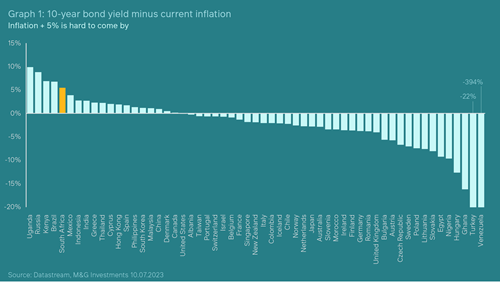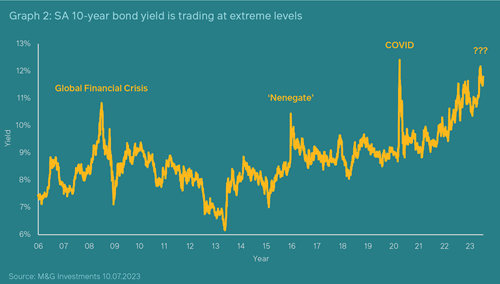Local assets still more attractive than offshore
Despite the challenging year 2023 has proved to be so far in South Africa, in our view local assets are still clearly offering better prospective returns for the risks involved over the next three to five years than their global counterparts. This means that at M&G Investments our multi-asset portfolios like the M&G Balanced and Inflation Plus Funds favour South African equities and bonds, although select global equities and bonds are also attractive, and offshore assets play critical roles as diversifiers to achieve the best possible risk/return balance for our clients.
Global equities versus SA equities
One of the most compelling reasons for our positioning is the differential between the valuations of global and South African equities. In aggregate, global equities are trading slightly cheaply compared to their long-run equilibrium or fair value, which is reflecting the cheapness of many global equity markets offset by the relative expensiveness of the US market. US share prices have been driven up primarily by the large tech stocks associated with artificial intelligence (the so-called “Magnificent Seven”) which have surged ahead, pushing the MSCI ACWI 12-month forward P/E ratio to 16.4X at the end of June from 15.8X at the beginning of April. Subsequently this rally has broadened.
Meanwhile, many other global equity markets are still trading at attractive levels, while company earnings reports have been mixed, with some starting to reflect downward revisions as they feel the effects of central banks’ aggressive monetary tightening. Because there are still unresolved questions around risks to earnings going forward, we are neutrally positioned in global equities and remain selective: we continue to be underweight US equities, as well as Canada and Australia. We prefer the UK, Japan, China and certain other emerging markets that are relatively cheap, and most recently added to our holdings in European banks, Japan and China.
In China an additional risk premium has been priced into equities, with depressed multiples on depressed earnings, largely as a consequence of geopolitical factors such as the Russia-Ukraine war and Taiwan. Yet the economy is recovering – albeit not as strongly as hoped – and the yuan is weak, inflation is low, and the government has low foreign debt, all making the country very competitive. Equally, a number of fresh government stimulus initiatives are expected, particularly targeting the local housing market where the initial brunt of the weakness has manifested. These measures should be effective in helping to limit macroeconomic downside risk in China, especially as we are not expecting to see the widespread fiscal giveaways which proved to be unproductive after the 2008 Global Financial Crisis.
In comparison with global equities, SA equity valuations (as measured by the 12-month forward Price/Earnings ratio of the FTSE/JSE Capped SWIX Index) were trading at 9.6X at the end of June, broadly reflecting depressed earnings expectations and low share prices. Investors are pessimistic about the country’s growth prospects, and therefore equally bearish around company earnings growth, particularly for the SA-centric companies. The causes for this are well-known, among the most important being the intensive loadshedding, high interest rates, low business investment levels, and elevated geopolitical risks.
However, we believe this presents real opportunities for careful investors. As market valuations currently stand, our analysis shows that current market pricing is implying SA equities have a prospective real return of 9.4% p.a. over the next five years, compared to global equities at 5.9% p.a. and US equities at only 5.0% p.a.. This is well above the local market’s long-term fair value of around 7.0% p.a..
Excellent potential returns at cheap valuations
In our view, there have been some excellent opportunities to pick up high-quality companies at cheap valuations. There are those that benefit from a weaker rand by becoming more competitive, like exporters, and those who can take advantage of higher interest rates, like banks. Additionally, companies with healthy balance sheets, little debt, and/or strong cash flows can still invest for future growth and gain an advantage over their peers. These are the types of companies that should perform well going forward – and we have invested in many at valuations that should more than compensate shareholders for the risks involved, as well as being cheaper than many of those to be found overseas.
Our portfolios include a well-considered mix of rand-hedge, “SA Inc”, defensive and attractive shares, with some of our preferred shares being BAT, Richemont, MTN, Textainer, Glencore, Reinet, Naspers/Prosus, and a collective overweight exposure to SA banks like Standard Bank, Absa and Investec.
Looking ahead, there are some factors that can provide tailwinds to the SA equity market, including falling inflation, a shift to expansionary monetary policy/interest rate cuts both globally and locally, private sector contributions to new sources of power supply and improving infrastructure, and the government’s acknowledgement of the urgent need to improve its service delivery.
Global bonds vs SA bonds
The investment case for South African bonds over global bonds is even more compelling than that for equities. A look at Graph 1 shows how the real yield on South Africa’s 10-year government bonds, at well over 5%, is far more attractive than that of 10-year US Treasuries at just over 1%. In fact, SA real bond yields are more attractive than those of most other countries, with the market pricing in a higher risk premium following the reported Russian arms sale incident in May. During that sell-off we were able to add more bonds to our already-overweight portfolios at extremely attractive yields.
As market valuations currently stand, our analysis shows that SA nominal bonds have a prospective real return of 6.6% p.a. over the next five years, compared to US Treasuries at only 1.4% p.a.. and global bonds at 1.3%.

Graph 2 shows how extreme the current levels are compared to history, having nearly reached highs comparable to the Covid crisis and far exceeding those seen during the 2008 Global Financial Crisis (GFC) and Nenegate in 2015.

While we acknowledge that investor risks are more elevated than they were at the start of the year, they are certainly not higher than during the GFC or Covid. Current yields are pricing in a very unlikely scenario of local inflation remaining well above the SA Reserve Bank’s 3-6% target range indefinitely – despite June CPI having already fallen back to 5.4% y/y and the SARB’s strong track record combatting inflation. At the same time, South Africa has a favourable history of repaying its debt, and is not on the brink of defaulting. In our view, current yields will more than compensate investors for their associated risks, and patient investors will be well rewarded.
Meanwhile, we do also own global bonds in our portfolios, given that they are offering fair real yields and serve as solid diversifiers for South African equity risk. As in global equities, we are neutrally positioned due to the risks associated with global inflation and interest rates, and prefer 30-year Treasuries and 30-year UK gilts, as well as selected sovereign emerging market bonds where the real yields are high and the currency trading at fair-to-cheap levels. Indonesian government bonds are a good example of this preference.
To conclude, we believe that our multi-asset portfolios, with their blend of very attractively priced local assets and fair-to-cheap global assets, are well-positioned to deliver above-market returns to investors over time. Current sentiment may favour the seemingly “safer” global options, but in these conditions our long-proven investment process indicates that the “safest” way to deliver excellent returns to our clients is to remain overweight in cheaper South African assets, while maintaining our neutral positioning in global assets primarily for their diversification benefits.
Share
Did you enjoy this article?
 South Africa
South Africa Namibia
Namibia




 Get the Newsletter
Get the Newsletter